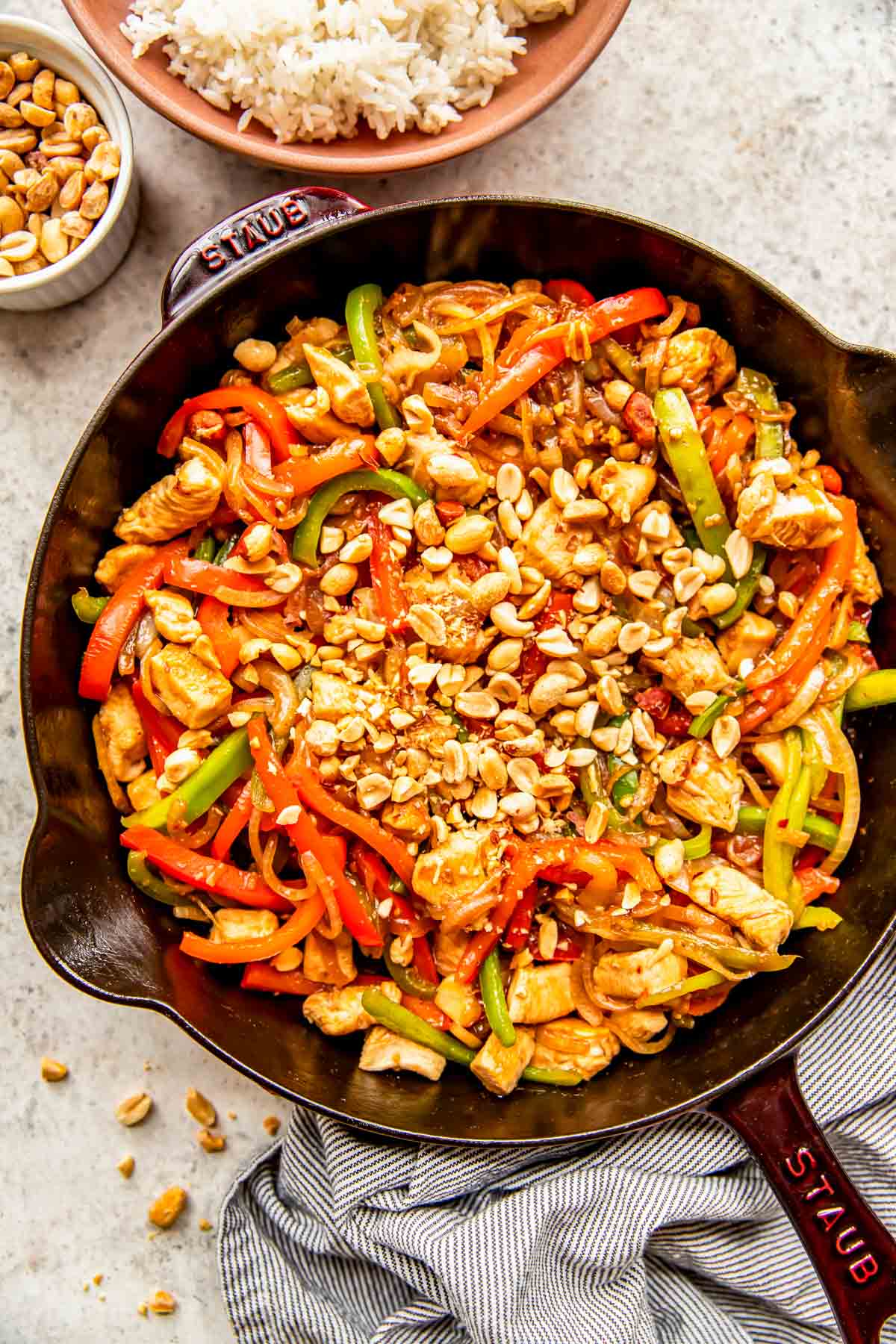Kung Pao Chicken, a Chinese-American takeout classic features tender chunks of chicken tossed in a sweet, sour, and slightly spicy sauce along with crunchy roasted peanuts, bell peppers, onions, and red pepper flakes. Every bite packs in a bunch of flavor and there is just the right amount of heat to keep things spicy!
Look, I totally get that it’s tempting to order take-out! Whether you just had a long day or want to relax on the weekends, Chinese takeout usually sounds like a good idea.
Now, what if I told you this recipe for Kung Pao chicken recipe wasn’t just more delicious and fresher than takeout, but it was also incredibly easy to whip up?! In the time that you spend waiting for your DoorDash order to reach your house, you could’ve made a way better dinner!

Ingredients for Kung Pao Chicken
- Vegetable oil
- Chicken breast – use boneless skinless chicken breasts here or if you prefer chicken thighs, you can substitute for that as well.
- Bell peppers – a variety of colors makes this dish vibrant! I used red and green. Feel free to use all of the same or mix it up to whatever you can find.
- Onion
- Garlic
- Low-sodium soy sauce – if you’re gluten-free, tamari is a great substitute.
- Dry sherry – if you can’t have alcohol, you may omit this or if you can find sherry vinegar, it could work. Just make sure you taste the sauce – doubling the vinegars may make it too tangy.
- Rice wine vinegar – this gives the sauce that tangy bite. You may substitute with white vinegar if you don’t have rice vinegar.
- Dark brown sugar – for that sweetness!
- Cornstarch – this helps thicken the sauce to coat every ingredient!
- Crushed red pepper flakes – add more or less if you like. If you have red chilies, you can use those instead for an even more fiery kick!
- Roasted peanuts – add as much as you want!
- Green onions – this is for garnish and extra flavor. It’s optional.
- Cooked rice – white rice for serving! Try my easy jasmine rice.

Tips for Success
- Chop all the ingredients ahead of time. This saves you time and since this dish comes together so quickly, you’ll be ready to go!
- Use high heat. High heat in Asian cooking is always a must. This helps with the flavor and also gets those ingredients all nice and cooked fast.
- Adjust the sauce to taste. As with all sauces, you want to adjust to taste before pouring it all over your dish! You can easily adjust prior but you can’t take it out!
FAQs
Why is it called Kung pao chicken?
Kung pao chicken takes its name from a famous early 20th century Chinese governor and military leader named Ding Baozhen. He had the title “Gongbao” which is where “kung pao” comes from. Apparently he was a real spice lover and had his personal chefs create this fiery stir-fry dish for him.
what is the difference between general tso and kung pao chicken?
Mainly in the sauce and how it’s prepared. General Tso sauce is thicker and sweeter while Kung Pao sauce is thinner, slightly spicier, and uses more vinegar.
General Tso also uses battered, deep-fried chicken pieces while Kung Pao doesn’t. General Tso also contains no veggies and Kung Pao has a lot of veggies.
is general tso’s hotter or kung pao?
Kung Pao is generally spicier than General Tso’s mainly because of the origins of Kung Pao.
what is the kung pao flavor like?
Savory, tangy, and spicy.

Storage Instructions
Allow leftovers to cool before transferring to an airtight container. Refrigerate for up to 4 days in the refrigerator. To reheat, place in the microwave and warm through or pour the leftovers into a skillet and reheat on the stove.
Serving Suggestions
Kung Pao chicken is best served with white rice but fried rice would be SO good as well. To make a big Chinese takeout feast at home, I highly recommend making some Crab Rangoon or Cream Cheese Wontons for an appetizer!
Cook ModePrevent your screen from going dark
-
In a small bowl whisk together soy sauce, dry sherry, rice vinegar, dark brown sugar, cornstarch, and crushed red pepper flakes. Set aside.
-
In a 12-inch skillet set over medium-high heat add vegetable oil.
-
When the oil is hot, add in the chicken and cook until browned on the outside and almost fully cooked, about 5 minutes.
-
Remove the chicken from the pan and add-in bell peppers and onion.
-
Saute until the peppers and onions just start to soften. Add in the garlic and saute for another 30 seconds until fragrant.
-
Add the chicken back to pan.
-
Pour the sauce into the skillet and lower the heat to medium. Cook just until the sauce starts to thicken and coats the chicken and vegetables.
-
Remove from the heat and stir in peanuts and garnish with green onions (if using).
-
Serve over cooked white rice.
Serving: 1serving (247 grams), Calories: 304kcal, Carbohydrates: 15g, Protein: 29g, Fat: 15g, Saturated Fat: 2g, Polyunsaturated Fat: 6g, Monounsaturated Fat: 4g, Trans Fat: 0.1g, Cholesterol: 73mg, Sodium: 473mg, Potassium: 765mg, Fiber: 3g, Sugar: 7g
This website provides approximate nutrition information for convenience and as a courtesy only. Nutrition information can vary for a variety of reasons. For the most precise nutritional data use your preferred nutrition calculator based on the actual ingredients you used in the recipe.
The default measuring system for this website is US Customary. Unit conversions are provided for convenience and as a courtesy only. While we strive to provide accurate unit conversions, please be aware that there may be some discrepancies.
Photographs by Meg McKeehan Photography







